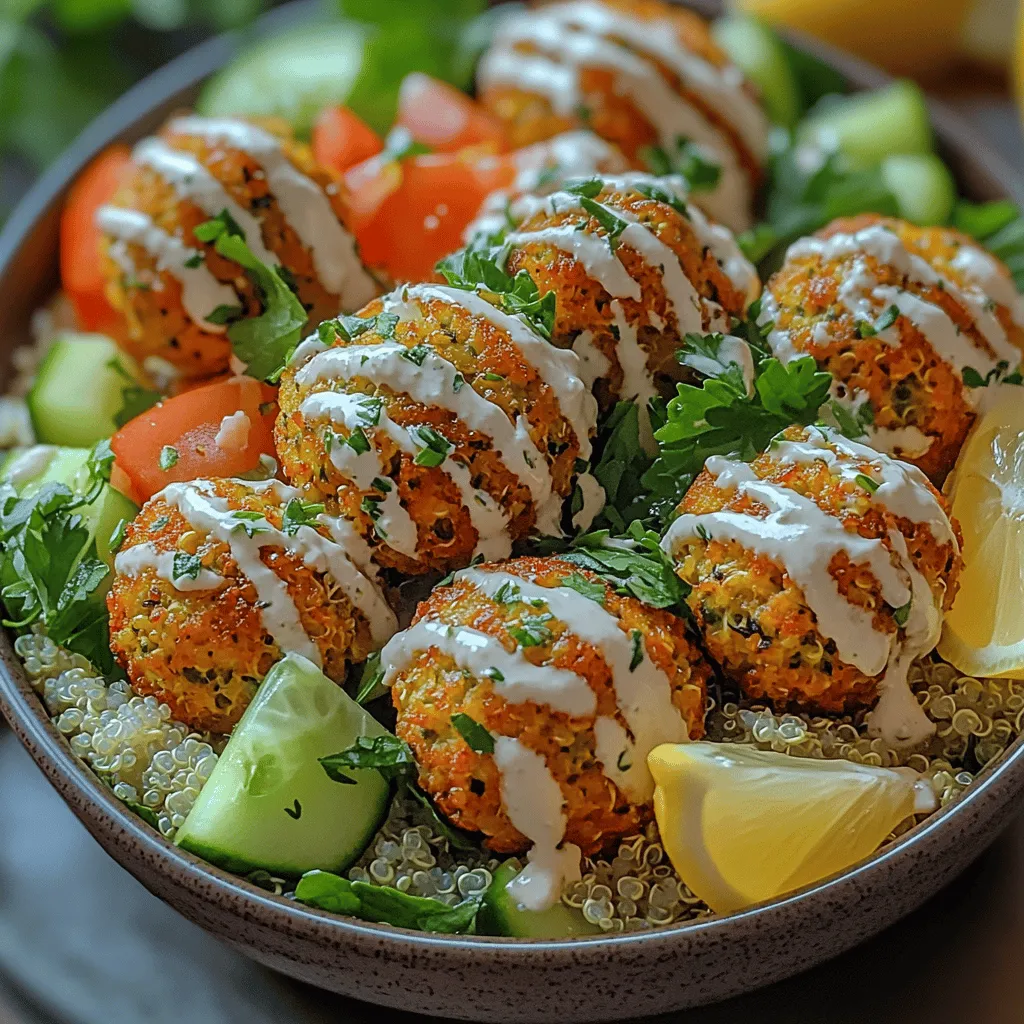Introduction to Baked Falafel Power Bowls
In recent years, plant-based meals have surged in popularity, driven by a growing awareness of health and environmental issues associated with traditional diets. More people are recognizing the benefits of consuming whole, plant-based foods, and one dish that encapsulates this movement beautifully is the Baked Falafel Power Bowl. This recipe not only satisfies cravings for a hearty meal but also packs a nutritional punch, making it an ideal choice for lunch or dinner.
Baked Falafel Power Bowls are particularly appealing as they cater to a diverse audience, including both vegans and non-vegans. The star of the show, falafel, is a protein-rich, flavor-packed dish made primarily from chickpeas, which are celebrated for their health benefits. These bowls are versatile, allowing for customization based on personal dietary preferences and ingredient availability. Whether you are looking to boost your intake of plant-based proteins or simply want a delicious and satisfying meal, Baked Falafel Power Bowls are an excellent solution.
Understanding the Ingredients
At the heart of this recipe lies a combination of wholesome ingredients that not only contribute to the flavor but also to the overall health benefits of the dish. Let’s delve deeper into these key components:
Chickpeas
Chickpeas, also known as garbanzo beans, are the primary ingredient in falafel. They are an excellent source of plant-based protein, offering about 15 grams of protein per cooked cup. Additionally, chickpeas are high in dietary fiber, with roughly 12 grams per serving, which aids in digestion and promotes feelings of fullness. Their low glycemic index makes them a suitable option for maintaining stable blood sugar levels. Furthermore, chickpeas are rich in essential vitamins and minerals, including folate, iron, and magnesium, making them a nutritional powerhouse.
Fresh Herbs
Fresh herbs, specifically parsley and cilantro, play a pivotal role in enhancing the flavor profile of the falafel. Parsley is not only a flavorful addition but also a source of antioxidants and vitamins A, C, and K. It may contribute to heart health and has been linked to improved digestion. Cilantro, on the other hand, is known for its unique taste and potential health benefits, including anti-inflammatory properties. The combination of these herbs not only elevates the taste but also adds a burst of freshness to the dish, making it more appealing.
Spices
The use of spices such as cumin, coriander, and paprika is what truly sets falafel apart. Cumin brings a warm, earthy flavor that is often associated with Middle Eastern cuisine, while coriander adds a citrusy note that brightens the dish. Paprika, with its sweet and smoky undertones, rounds out the flavor profile, providing depth and complexity. These spices not only contribute to the taste but also offer various health benefits, including anti-inflammatory and antioxidant properties.
Whole Wheat Flour
While chickpeas provide the bulk of the falafel, a small amount of whole wheat flour is essential for binding the ingredients together. Whole wheat flour adds fiber and nutrients compared to its white counterpart, making the falafel more wholesome. For those with gluten sensitivities, alternatives such as almond flour or chickpea flour can be used, ensuring the recipe remains accessible to everyone.
Tahini Dressing
No falafel bowl is complete without a creamy dressing, and tahini is the perfect choice. Made from ground sesame seeds, tahini is rich in healthy fats, particularly monounsaturated fats, which can support heart health. It is also a good source of calcium, magnesium, and B vitamins. The creamy texture of tahini adds a luxurious element to the power bowl, while its nutty flavor complements the other ingredients beautifully.
Preparation Details
Now that we understand the ingredients, it’s time to dive into the preparation of Baked Falafel Power Bowls. The following steps will guide you through the process of creating this delicious dish.
Preheating the Oven
The first step in preparing Baked Falafel is to preheat your oven to 400°F (200°C). Preheating is crucial for achieving even cooking and ensuring that the falafel develops a crispy exterior while remaining tender on the inside. This step sets the stage for a perfectly baked falafel that will hold its shape and texture.
Making the Falafel Mixture
To create the falafel mixture, start by rinsing and draining your canned chickpeas or soaking dry chickpeas overnight (if using dried). Next, place the chickpeas in a food processor along with the fresh herbs, spices, and a bit of whole wheat flour. Pulse the mixture until it reaches a coarse consistency—avoid over-processing, as you want to maintain some texture for a satisfying bite. If the mixture seems too dry, a splash of water can help bind the ingredients without making it too mushy.
Forming the Falafel Balls
Once the mixture is ready, it’s time to shape it into falafel balls. Using your hands or a cookie scoop, portion out the mixture into small balls, about the size of a golf ball. This size ensures they cook evenly while still being easy to eat. Gently roll them into balls and place them on a parchment-lined baking sheet. For an added touch, you can lightly flatten the balls to create patties, which will also increase the surface area for crispiness.
Baking the Falafel
Baking the falafel is where the magic happens. Lightly coat the falafel balls with a drizzle of olive oil to promote browning and crispiness. Bake in the preheated oven for about 20-25 minutes, flipping them halfway through to ensure even cooking. The result should be golden brown and crispy falafel that is bursting with flavor, ready to be assembled into your power bowl.
Building the Power Bowl
Now that your baked falafel is prepared, it’s time to put together the power bowl. The base is a crucial component of the dish, and here you have some delicious options to consider.
Choosing the Base
When it comes to selecting a base for your Baked Falafel Power Bowl, quinoa and brown rice are two popular choices. Quinoa is a complete protein, meaning it contains all nine essential amino acids, making it a fantastic option for those looking to maximize their protein intake. It’s also gluten-free and packed with fiber, vitamins, and minerals.
On the other hand, brown rice is a whole grain that offers a hearty texture and nutty flavor. It is rich in fiber and provides a good source of energy. Both options have their unique benefits and can be tailored to your taste preferences. Whether you choose quinoa or brown rice, both provide a nutritious foundation for your falafel and contribute to the overall healthfulness of the dish.
With the falafel baked to perfection and your base selected, you are well on your way to creating a delicious and nutritious Baked Falafel Power Bowl that is sure to impress. Stay tuned for the next part of this article, where we will explore additional toppings, assembly tips, and variations to make this dish your own.
Adding Fresh Vegetables
To elevate your Baked Falafel Power Bowls, incorporating fresh vegetables like cucumbers and tomatoes is essential. These vibrant ingredients not only add color but also provide a refreshing crunch that complements the savory falafel. Cucumbers, with their high water content, are hydrating and crisp, while tomatoes bring a burst of sweetness and acidity that helps balance the flavors in the bowl.
Benefits of Cucumbers and Tomatoes
Cucumbers are low in calories and packed with vitamins K and C, making them a fantastic addition to any meal. Their crunchiness can break up the creaminess of tahini dressing, adding a delightful texture.
Tomatoes, on the other hand, are rich in antioxidants, particularly lycopene, which has been linked to various health benefits, including heart health. They also provide a good dose of vitamin C, which can help boost your immune system.
By adding these vegetables, not only do you enhance the overall aesthetic of your power bowl, but you also increase its nutritional value, making your meal even more satisfying.
Layering the Ingredients
A well-presented dish is often more appetizing, and Baked Falafel Power Bowls are no exception. The way you layer your ingredients can make a significant difference in both taste and visual appeal. Here’s how to layer your bowl for maximum impact:
1. Start with the Base: Begin with your chosen grain, such as quinoa or brown rice, as the foundation. This not only provides a hearty base but also helps absorb the flavors of the other ingredients.
2. Add Falafel: Next, place your baked falafel on top of the grain. Ensure they are evenly spaced to create an inviting look.
3. Incorporate Vegetables: Next, artfully arrange slices of cucumber and diced tomatoes around the falafel. You can even create a colorful pattern or stack them for an appealing look.
4. Drizzle with Dressing: Finally, finish with a generous drizzle of tahini dressing. The creamy texture will beautifully coat the vegetables and falafel, adding richness to the dish.
5. Garnish: Consider finishing with fresh herbs like parsley or cilantro for a pop of color and an extra layer of flavor.
The careful arrangement of components not only enhances the visual appeal of your power bowl but also ensures that every bite is balanced and flavorful.
Serving Suggestions
To make your Baked Falafel Power Bowls even more delightful, consider these serving suggestions.
Tahini Dressing
The dressing can make or break your dish, and tahini dressing is a classic choice that pairs beautifully with falafel. You have the option of purchasing store-bought tahini dressing for convenience, but making your own is simple and rewarding.
Quick Homemade Tahini Dressing Recipe:
– Ingredients:
– 1/4 cup tahini
– 2 tablespoons lemon juice
– 1 clove garlic, minced
– Water to thin
– Salt and pepper to taste
Instructions:
1. In a bowl, whisk together tahini, lemon juice, and minced garlic.
2. Gradually add water until you reach your desired consistency.
3. Season with salt and pepper to taste.
This homemade dressing is creamy, tangy, and full of flavor, making it a perfect complement to your falafel.
Lemon Wedges
Incorporating lemon wedges into your meal is a simple yet effective way to brighten the flavors of your Baked Falafel Power Bowls. Squeezing fresh lemon juice over the bowl right before eating adds acidity that enhances all the other flavors. It can cut through the richness of the tahini and provide a refreshing contrast to the savory falafel.
Pairing Ideas
To enhance the meal experience, consider serving your power bowls with complementary side dishes or beverages.
Recommended Pairings:
– Side Dishes: A side of tabbouleh or a simple leafy green salad can add freshness and variety to your meal.
– Beverages: Pair with a light, refreshing drink like iced herbal tea or sparkling water with a slice of lemon for a delightful touch.
Nutritional Benefits of Baked Falafel Power Bowls
Baked Falafel Power Bowls are not only delicious but also packed with nutrients that support a healthy lifestyle.
Macronutrient Breakdown
A typical serving of these power bowls will provide a balanced macronutrient profile.
– Protein: Each falafel ball contains protein from chickpeas, making it a great option for vegetarians and vegans.
– Carbohydrates: The inclusion of grains like quinoa or brown rice provides complex carbohydrates, which help sustain energy.
– Fats: Healthy fats from tahini contribute to satiety and flavor without compromising health.
Micronutrient Content
The ingredients in Baked Falafel Power Bowls are rich in essential vitamins and minerals:
– Vitamin C: Found in cucumbers and tomatoes, supporting immune health.
– Iron: Present in chickpeas and quinoa, essential for blood health.
– Fiber: The combination of grains and vegetables contributes to digestive health.
Dietary Considerations
This recipe is highly versatile, making it suitable for various dietary needs. It is naturally vegan, gluten-free (if you choose gluten-free grains), and can be easily adapted for those with nut allergies by substituting tahini with sunflower seed butter.
Culinary Variations
One of the best aspects of Baked Falafel Power Bowls is their adaptability. Here are some ideas for customizing your dish:
Ingredient Swaps
Feel free to switch out vegetables or grains based on your preferences. For example:
– Vegetables: Substitute bell peppers, shredded carrots, or shredded cabbage for a different crunch and flavor.
– Grains: Use farro, barley, or cauliflower rice for a low-carb option.
Flavor Enhancements
You can also add additional spices or toppings to elevate the flavor profile:
– Spices: Consider adding smoked paprika or cumin to your tahini dressing for an extra kick.
– Toppings: Crumbled feta, olives, or avocado slices can add richness and depth.
Meal Prep Option
Baked Falafel Power Bowls are perfect for meal prepping. To make this a convenient option:
– Storage: Store the falafel, grains, and vegetables separately to maintain freshness.
– Reheating: When ready to eat, simply reheat the falafel in an oven until warm and assemble your bowls with fresh ingredients.
Conclusion: Embracing Healthy Eating with Baked Falafel Power Bowls
Incorporating Baked Falafel Power Bowls into your diet is a delicious way to enjoy healthy eating. Their versatility allows for endless adaptations, from ingredient swaps to flavor enhancements, ensuring that you never get bored with the same meal.
Not only are these bowls rich in flavor, but they also provide an excellent source of plant-based protein, fiber, and essential vitamins and minerals. Preparing your own falafel and assembling the bowls at home allows you to control the ingredients, making this dish both satisfying and nutritious.
Whether you’re looking for a quick lunch, a hearty dinner, or a meal prep option for the week, Baked Falafel Power Bowls offer a healthful solution that is easy to prepare and enjoyable to eat. Embrace the joy of plant-based cooking and discover how delicious healthy meals can be!


